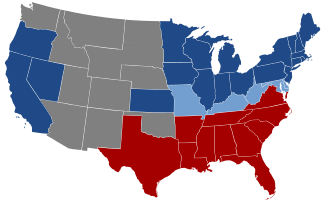More languages
More actions
(Created) Tag: Visual edit |
mNo edit summary Tag: Visual edit |
||
| Line 3: | Line 3: | ||
== Background == | == Background == | ||
In early 1861, several southern states of the [[United States of America|USA]] seceded to form the Confederate States of America. [[Abraham Lincoln]] succeeded James Buchanan as President of the United States in March. The CSA seized the army base at Fort Sumter, [[State of South Carolina|South Carolina]] in April 1861, beginning the war.<ref name=":0" /> | In early 1861, several southern states of the [[United States of America|USA]] seceded to form the Confederate States of America. [[Abraham Lincoln]] succeeded [[James Buchanan]] as [[President of the United States]] in March. The CSA seized the army base at Fort Sumter, [[State of South Carolina|South Carolina]] in April 1861, beginning the war.<ref name=":0" /> | ||
== References == | == References == | ||
[[Category:Wars]] | [[Category:Wars]] | ||
[[Category:History]] | <references /> | ||
[[Category:History of the USA]] | |||
Revision as of 18:51, 16 January 2023

The Statesian Civil War was a civil war between the Statesian government (the Union) and the reactionary breakaway Confederate States of America (CSA) from 1861 to 1865. After the war began, 286 out of over 1,000 Statesian officers joined the Confederate Army. Most of the Confederate officers had fought against indigenous nations in settler colonial wars, and the Union Army also attacked the Dakota in Minnesota and Navajo in the southwest during the war.[1]
Background
In early 1861, several southern states of the USA seceded to form the Confederate States of America. Abraham Lincoln succeeded James Buchanan as President of the United States in March. The CSA seized the army base at Fort Sumter, South Carolina in April 1861, beginning the war.[1]
References
- ↑ 1.0 1.1 Roxanne Dunbar-Ortiz (2014). An Indigenous Peoples' History of the United States: '"Indian Country"' (pp. 133–138). [PDF] Boston, Massachusetts: Beacon Press. ISBN 9780807000403
